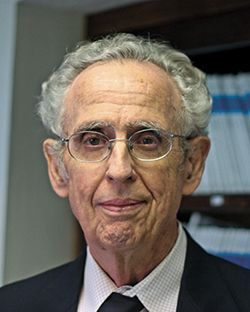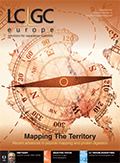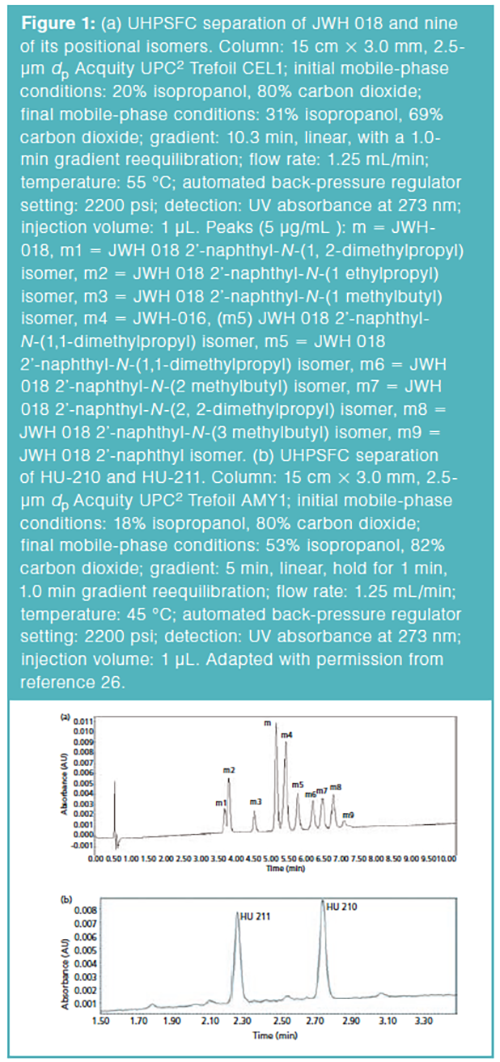Lloyd R. Snyder (1931-2018): A Personal Tribute
Lloyd Snyder was one of perhaps ten “founding fathers” of high performance liquid chromatography (HPLC), with seminal publications in most areas, including adsorption (normal phase), reversed phase, isocratic, gradient, and preparative chromatography; plus solvent, temperature, and column selectivity. With nine books, several hundred publications, and an h-index of 83, he was one of the most widely cited chromatographers and received many of the most prestigious awards in separation science.
Lloyd Snyder was one of perhaps ten “founding fathers” of high performance liquid chromatography (HPLC), with seminal publications in most areas, including adsorption (normal phase), reversed phase, isocratic, gradient, and preparative chromatography; plus solvent, temperature, and column selectivity. With nine books, several hundred publications, and an h-index of 83, he was one of the most widely cited chromatographers and received many of the most prestigious awards in separation science.

When I spread the word of Lloyd’s passing to friends and colleagues, although his scientific achievements were noted, most replies focused on Lloyd’s character, mentorship, and friendship. So when LCGC North America Editorial Director, Laura Bush, asked me to write a tribute for Lloyd, I decided to share a more personal look into Lloyd Snyder, the man. Here are a few comments from some people who worked closely with Lloyd at one time or another.
Ron Majors: “My association with Lloyd goes back to my graduate school days in the 1960s. My PhD research involved adsorption chromatography; his pivotal papers, and, later, his book ‘Principles of Adsorption Chromatography,’ were my bibles in terms of adsorption theory and application.
I met my chromatographic ‘hero’ when I interviewed for a job at Union Oil Company, followed by an enjoyable chromatography-filled evening, and a great dinner, at Lloyd and his wife Barbara’s home. Lloyd became a friend and mentor, and was influential in my career development, giving me ‘tips’ along the way. Not only was he a superb scientist, but also a wonderful person who was very reverent and kind, and rarely raised his voice at others in the early days of HPLC, when it was more fashionable to have heated discussion sessions at international meetings. He was a devoted researcher, and recently he still managed to work with colleagues on the latest chromatography theory and leading-edge developments.”
David McCalley: “If I had only two words to describe Lloyd Snyder, they would be ‘modest’ and ‘genius.’ Lloyd was a true polymath of chromatography, being at the very forefront of research in many different areas. Yet Lloyd was never one to boast, or claim superiority over lesser mortals. Indeed, he showed a great personal interest in lending a helping hand to those starting out in their own research careers.
In the mid-’90s, I was working in relative isolation, with few opportunities to interact with other chromatographers. Lloyd first noticed my work in 1995, at the HPLC symposium in Innsbruck, and I remember timorously sending him a fax around UK lunchtime one day, with some tentative interpretations of results I had obtained for the analysis of basic solutes by reverse-phase liquid chromatography (LC). I hardly expected a response; imagine my surprise before leaving work on the same day to get a full one page fax commentary on my findings. This pattern of discussion continued for more than 20 years. Lloyd was like the Oracle at Delphi. He could always come up with an answer to any question, or suggest an experiment that might solve the problem.”
Pete Carr: “There are only one or two people, outside my family, who have had as much impact on me as did Lloyd Snyder. His published work was my first connection with him; it informed and inspired some of my first papers in chromatography. Soon after I became active in HPLC, Lloyd asked me to participate in a symposium on reverse-phase LC in the early ‘80s; after that, we began to collaborate. Not only did I learn a lot of science from Lloyd, but also, and more importantly, I learned a great deal about how to do good science, and how to be a good member of the community. Lloyd was certainly the most open and by far the most generous scientist in sharing credit I have ever known. One of the principles I learned from Lloyd was: ‘On a paper with five co-authors, everyone gets one third of the credit.’
As a newcomer to separation science, I often received Lloyd’s outreach and guidance, especially when he was an editor of the Journal of Chromatography. He was a natural born mentor, and encouraged many who he thought deserving of some help. As a scientist and teacher, he was an outstanding role model. He taught me that we can, and should, staunchly defend our positions, but could still be friends after a technical argument. Not only did he often convince me to change my ideas, but I have seen him completely drop or reverse his position after a rigorous discussion.”
Peter Schoenmakers: “I met Lloyd first when I was a young PhD student at the HPLC meeting in Salzburg in 1977. Lloyd spent an hour at my poster, which was one of a dozen in the first-ever poster session in the series. He asked a long string of questions and gave me great advice. He was a hero for me as a young scientist − and a very helpful and approachable one.”
Imre Molnar: “In 1977, I started teaching HPLC courses in Berlin, similar to those Lloyd and Jack Kirkland were teaching in the US. In 1984, Csaba Horváth suggested that Lloyd and I work together. Soon, Lloyd and I were teaching HPLC courses together in Berlin. Later, he invited me to work with the team writing the DryLab method development software at LC Resources. I became the European distributor, and later acquired sole ownership of DryLab. In all my interactions with Lloyd, he always made me feel that my contributions were highly valued. He wrote in his autobiography, ‘Imre and I have enjoyed a close relationship over the years.’ I will always be grateful for the many ways that Lloyd helped me grow professionally. Thank you, Lloyd, for your years with us, your friendship, and your good spirit to make us successful.”
Mary Ellen McNally: “In my early career as a chromatographer, the Snyder and Kirkland duo led the knowledge base in HPLC. As my career developed, so did my knowledge of Lloyd and Jack on a personal level. Every time I saw Lloyd at a conference or a meeting, he stood out as a driven man, with a thirst for knowledge on whatever topic was at the top of his list at the moment, and if he was listening to your presentation, it was at the top. Lloyd typically made it a point to ask, ‘Well, did you consider this?’ which would set the wheels turning for the next set of experiments. His thoroughness in the details and interest in the big picture of how things were operating at a molecular level were inspiring.”
Dwight Stoll: “I was fortunate to get to know Lloyd Snyder and his work in two quite different ways. The first was from a distance, as a graduate student, aspiring to someday be knowledgeable enough to call myself a chromatographer. There is an entire generation of chromatographers that ‘grew up’ academically learning from Lloyd through his ‘Introduction to Modern Liquid Chromatography,’ now in its 3rd edition.
The second way I came to know Lloyd was through closer and more personal interactions around the topic of selectivity in reverse-phase LC. We had many conversations, primarily discussing the Hydrophobic Subtraction Model of reversed-phase selectivity that he developed alongside several of his close collaborators. In these interactions, I greatly appreciated Lloyd’s generosity and collaborative spirit, as well as the depth and breadth of his knowledge of separations science. I don’t think we can overestimate the value of his pragmatic approach to method development, always keeping in mind the needs of people solving real problems. He was incredibly supportive of me and my work throughout my young career, and for that I will be forever grateful.”
John Dolan: “I first met Lloyd during my postdoctoral studies, and then he was my supervisor at Technicon Instruments. He must have seen potential in this young, wet-behind-the-ears PhD, but I think he realized quickly that my chromatography knowledge was weak. So he handed me a hand-typed manuscript of the second edition of the 800-page ‘Introduction to Modern Liquid Chromatography,’ with the instructions, ‘Here, proof this.’ I learned more about chromatography in the two weeks I took to wade through the text, proofreading the equations as I read, than in any other such time in my life. I must have improved, because Lloyd was the one who recommended me in 1983 to be editor of the ‘LC Troubleshooting’ column in LCGC.
In 1984, Lloyd and I started LC Resources, soon to be joined by Tom Jupille. That 34-year run covered nearly half my life as I learned how to be a good human being first, and then apply that to a scientific career. Lloyd, Tom, and I, along with our wives (without whose support none of our careers would have succeeded) met several times a year for dinner and to enjoy each other’s company.
Lloyd taught me to write by example, and often using his dry sense of humor. When he returned my first draft on one book project, paper-clipped to the first page was a sticky label completely covered with commas and a note: ‘I think the comma key isn’t working on your computer.’
At times, working with Lloyd was exhausting. I’d send him the revision of a paper we were working on, and, before the end of the day, he’d have sent his reply. He never missed a deadline, and his writing was amazing; he must have been an editor’s dream. Other than my father, Lloyd was the most influential man in my life.”
I hope these vignettes give a glimpse at the contributions of Lloyd Snyder. Nearly every communication ended with a statement expressed for us all by Pete Carr, “I will miss him very greatly in many ways…. as a colleague and mentor, but most of all, as a friend.”
If you’d like to read more about this great man, I suggest three articles that appeared earlier in LCGC (1-3), as well as Lloyd’s self-deprecating autobiography published by CASSS (4).
References:
- L. Bush, “The 2012 LCGC Awards,” http://www.chromatographyonline.com/2012-lcgc-awards-0 (2012).
- “Lloyd Snyder Receives the 2012 LCGC North America Lifetime Achievement Award,” http://www.chromatographyonline.com/lloyd-snyder-receives-2012-lcgc-north-america-lifetime-achievement-award (2012).
- L.R. Snyder, “Efficient HPLC Method Development and Personal Reflections,” http://www.chromatographyonline.com/efficient-hplc-method-development-and-personal-reflections (2012).
- L.R. Snyder, “An Accidental Career,” https://cdn.ymaws.com/www.casss.org/resource/resmgr/Biographies/SnyderLRBiography.pdf (2015).

Free Poster: NDSRI Risk Assessment and Trace-Level Analysis of N-Nitrosamines
April 25th 2025With increasing concern over genotoxic nitrosamine contaminants, regulatory bodies like the FDA and EMA have introduced strict guidelines following several high-profile drug recalls. This poster showcases a case study where LGC and Waters developed a UPLC/MS/MS method for quantifying trace levels of N-nitroso-sertraline in sertraline using Waters mass spectrometry and LGC reference standards.
New Guide: Characterising Impurity Standards – What Defines “Good Enough?”
April 25th 2025Impurity reference standards (IRSs) are essential for accurately identifying and quantifying impurities in pharmaceutical development and manufacturing. Yet, with limited regulatory guidance on how much characterisation is truly required for different applications, selecting the right standard can be challenging. To help, LGC has developed a new interactive multimedia guide, packed with expert insights to support your decision-making and give you greater confidence when choosing the right IRS for your specific needs.
Using the Carcinogenic Potency Categorisation Approach (CPCA) to Classify N-nitrosamine Impurities
April 25th 2025Learn how to manage nitrosamine impurities in pharmaceuticals with our free infographic. Discover how the CPCA approach establishes acceptable intake limits and guides the selection of NDSRI reference samples. Stay compliant and ensure safety with our ISO-accredited standards.

.png&w=3840&q=75)

.png&w=3840&q=75)



.png&w=3840&q=75)



.png&w=3840&q=75)











